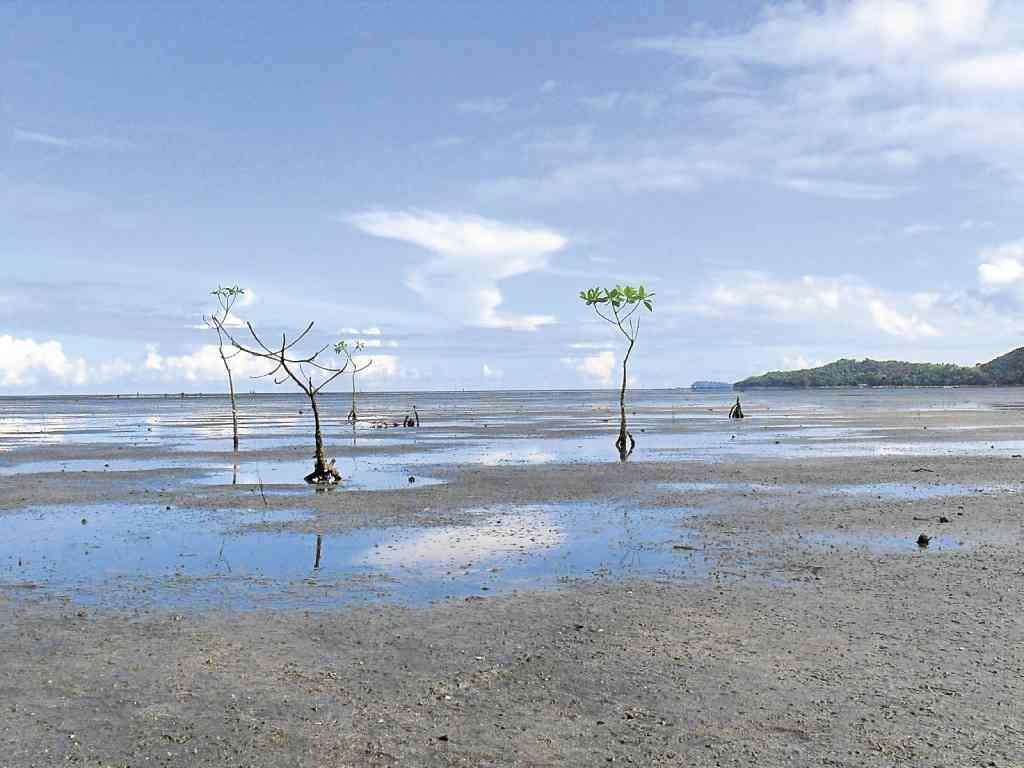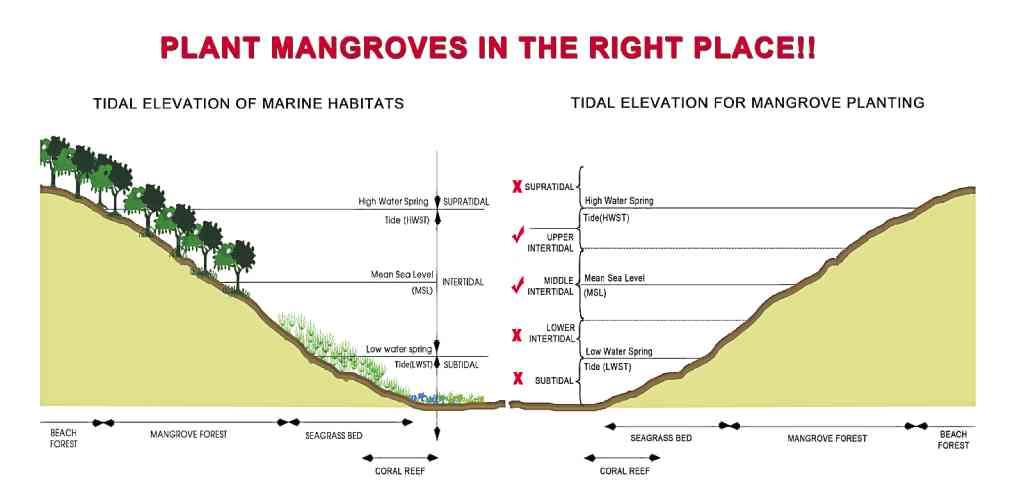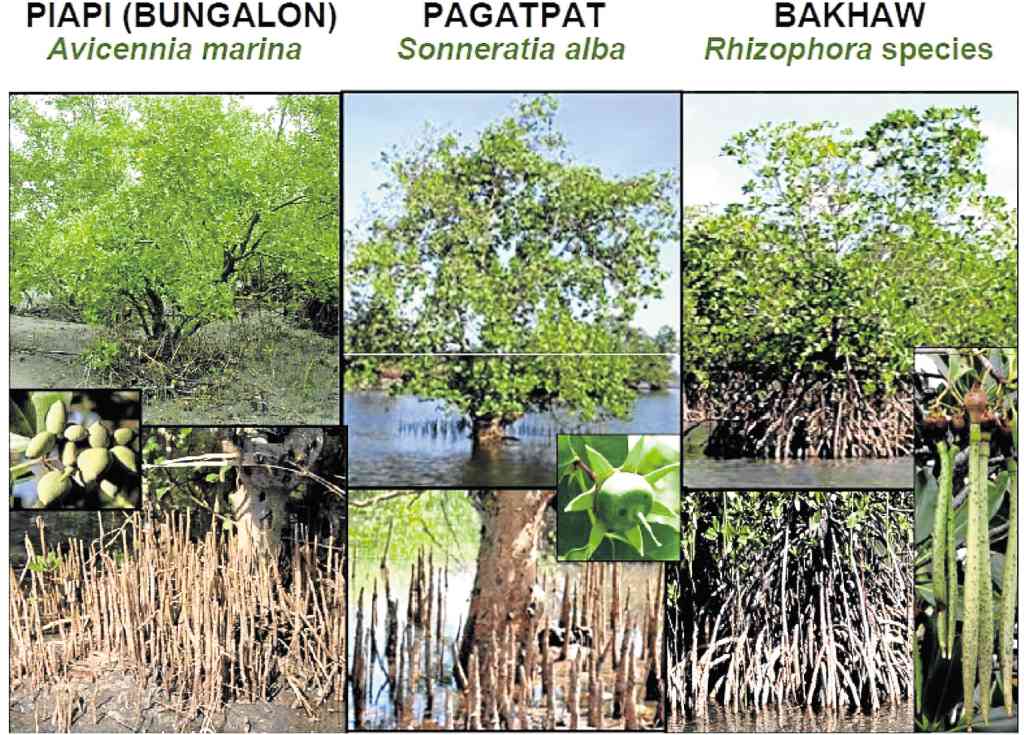Stop seafront planting of bakhaw propagules
Typhoon “Yolanda” in 2013 and the 2004 Indian Ocean tsunami, among others, have highlighted the importance of mangroves in coastal protection. Of global storm events, the Philippines has the greatest intensity (maximum score of 5 on the Saffir-Simpson Hurricane Intensity Scale) and number (one-third).
Mangroves have therefore captured public imagination—student, NGO, government, religious and business groups plant mangroves themselves or raise money for others to plant. Even the national government planned to allocate P1 billion for mangrove rehabilitation in Yolanda sites. Such massive amounts of taxpayers’ and private funds beg the question: Are the planting protocols science-based?
Mangroves are uniquely adapted to withstand harsh conditions of salty water and tidal inundation, but not more than 30 percent of the time. Hence mangroves are not uniformly distributed between high and low tide, but are found in the middle to upper intertidal levels (at or above mean sea level) where they remain mostly exposed (Fig. 1).
Adapted to different substrates
The 35-40 Philippine mangrove species are adapted to different substrates (sand, mud), salinity (full seawater, brackish water), but mainly to water level which determines how much flooding they can tolerate. Therefore most open seafronts are dominated by pagatpat (Sonneratia alba) and piapi (Avicennia marina) (Fig. 2) whose extensive lateral/cable roots firmly anchor the tree below ground. Bakhaw Rhizophora, whose aboveground prop/stilt roots cannot withstand strong wave/wind action, either hide behind the pagatpat-piapi zone, or line inner tidal rivers and creeks.
Article continues after this advertisementSo most bakhaw planted along the seafront are the wrong species in the wrong sites , as the scientific community has pointed out since the 1990s. Yet large Rhizophora propagules (or Tusok d Tongki, Cebuano for “sticking the propagules”) are favored over piapi/pagatpat whose small seeds require a nursery phase—planting by convenience, not by ecology. This misguided preference for bakhaw is seen in logos, posters and T-shirts that prominently feature iconic bakhaw prop roots instead of pencil- or cone-shaped pneumatophores (arising from lateral roots) of piapi/pagatpat.
Article continues after this advertisementWorse, the practice of seagrass planting continues to this day. In 2003, the Philippine Association of Marine Science called on the Department of Environment and Natural Resources to stop planting on seagrasses, a call repeated and disseminated to DENR field staff in 2005 and 2007. Yet 10 years later, seagrass beds in Cordova, Cebu were again planted to bakhaw financed by Oil Spill funds.
Unscientific transformation
According to National Scientist Edgardo Gomez, [some] foresters argue that if grasses can be planted to forests, likewise seagrasses can become mangroves, a well-meaning but unscientific transformation. Current mangrove programs also prefer to reforest the ecologically difficult but low- to no-conflict, open-access seafront. It should prioritize the biophysically-easier but sociopolitically-challenging reversion of abandoned ponds, where mangroves used to thrive.
A more worrisome practice has emerged—the Tongki Protocols, by which money is siphoned off reforestation budgets by unscrupulous parties. To switch from easy-to-source and easy-to-plant bakhaw to nursery-reared piapi/pagatpat will affect the modus operandi (and flow of money). Moreover, many mangrove programs are driven by Guinness and/or photo ops. In 2012, around 7,000 volunteers planted one million mangrove propagules in El Verde, Camarines Sur, targeting the Guinness Book of Records. Another million mangrove-planting event in Quezon province was named 2014 Galing Pook awardee.
There is nothing wrong with planting in the morning, posting Facebook photos in the evening, and print/TV media coverage the next day so long as planting is science-based. Unfortunately, the focus on initial planting forgets the end-product—the mature forest. Like graduation ceremonies, tree planting is only the commencement, yet media rarely report, if at all, the massive mortalities of failed plantings.
Mangrove survival rates
Tracking down mangrove survival rates in Camarines Sur via dozens of text/e-mail exchanges with local officials has been fruitless. Reluctance to share bakhaw monitoring data suggests high mortality rates. Not surprisingly the National Greening Program and other projects define reforestation success as the percent of target area or number of seedlings actually planted, rather than survival rates (which remain unreported). Yet mangroves and other trees are living beings whose measures of success are growth and survival.
Moreover, such commonplace mortality has led to the dubious but profitable practice of replacement planting, with payment based on number planted. The more plants that die, the more are replaced and, expectedly, the more money is paid. In contrast, “No Pay Planting” is promoted by the Zoological Society of London, an Iloilo-based NGO, on the premise that labor contributed by fisherfolk entitles them to mangrove ownership. Instead, the ZSL Community-based Mangrove Rehabilitation Project assists communities in applying for tenure, e.g. the Community-based Mangrove Forest Management Agreement. As owners and de facto managers, coastal folk are obligated to nurture the mangroves to maturity.
Deprive fauna of their habitats
Even when successful, bakhaw plantings on seagrass beds are one ecosystem’s gain and another’s loss. Conversion to mangrove forests will deprive mudflats and seagrass fauna, e.g. danggit (rabbitfish), dugong, crabs and birds of their habitats. At the least, white sand substrates turn dark muddy-sand. Interestingly, Philippine mangrove area increased from only 140,000 ha. in 1987-88 to 250,000 ha. in 2003. How many of over 100,000 hectares of new mangroves are former seagrass beds? The DENR and other agencies must account for such conversions, e.g., in Molacaboc, Negros Occidental and Olango, Cebu.
To all mangrove planters/conservationists: 1) Do not plant bakhaw on seagrass beds and mudflats; 2) Plant pagatpat/piapi in the middle-upper intertidal; and 3) Government agencies should report percent of surviving mangroves rather than percent of target seedlings/area planted.
(J.H. Primavera is chief mangrove scientific adviser of the Zoological Society of London, cochair of the IUCN Mangrove Specialist Group, scientist emerita of the SEAFDEC Aquaculture Department, and Pew Fellow in Marine Conservation. She will cover mangrove reversion of abandoned ponds in a sequel.)


